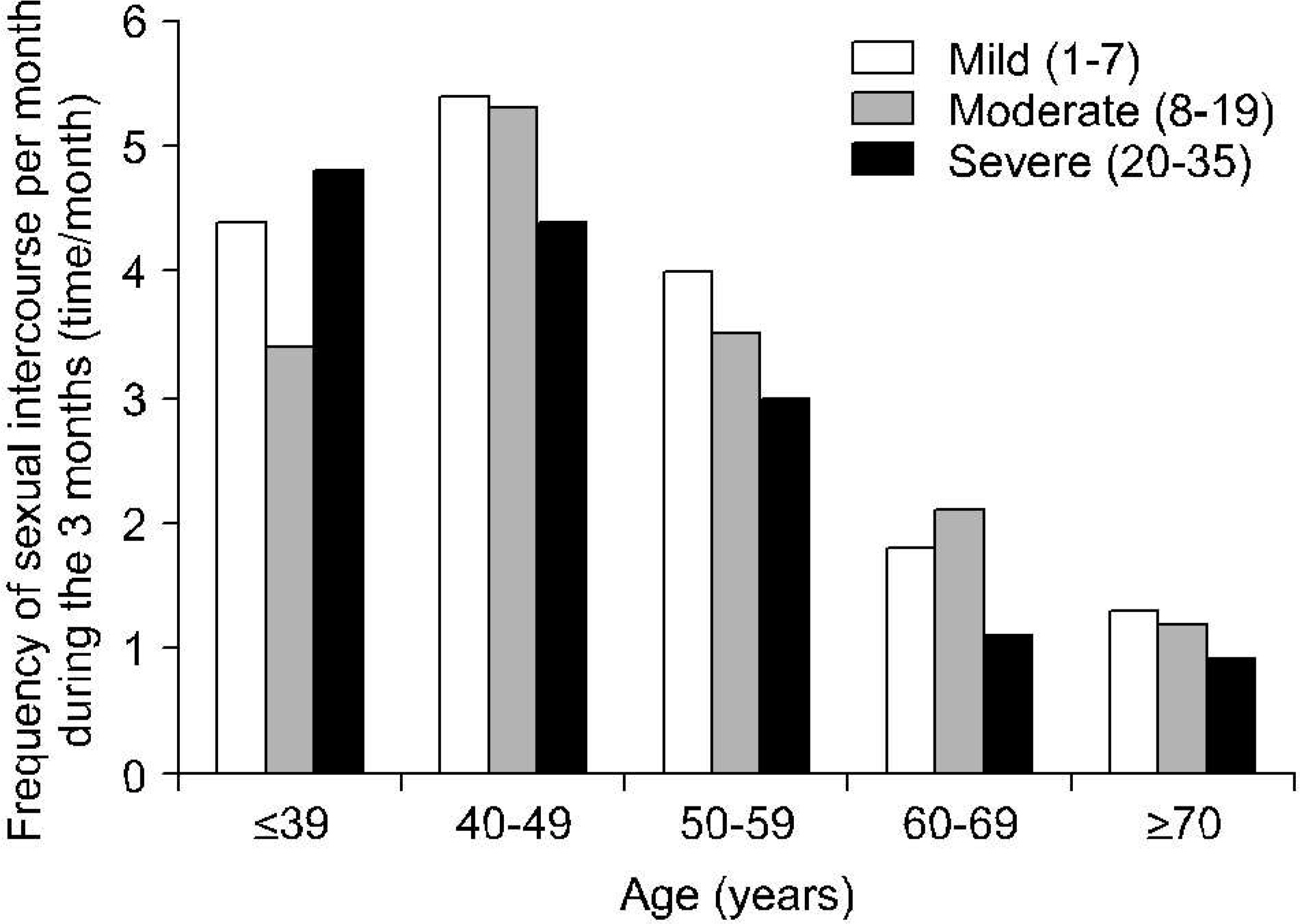Korean J Urol.
2007 Apr;48(4):458-462. 10.4111/kju.2007.48.4.458.
The Effect of Lower Urinary Tract Symptoms on Erectile Function and the Frequency of Sexual Intercourse
- Affiliations
-
- 1From the Department of Urology, College of Medicine, Inje University, Busan, Korea. ircho@ilsanpaik.ac.kr
- KMID: 1997116
- DOI: http://doi.org/10.4111/kju.2007.48.4.458
Abstract
- PURPOSE
Lower urinary tract symptoms (LUTS) usually co-exist with erectile dysfunction. Although the mechanisms for this are still unknown, there seems to be a correlation between the two diseases. We evaluated the effect of lower urinary tract symptoms on the erectile function and the frequency of sexual intercourse.
MATERIALS AND METHODS
1,216 patients, who visited our hospital due to LUTS from January 2000 to April 2006, were evaluated for their erectile function with using International Index of Erectile Function-Erectile Function (IIEF-EF) domain score, frequency of sexual intercourse per month during the last 3 months, prostate volume, International Prostate Symptom Score (IPSS) and quality of life (QoL). The patients were divided into five groups according to age: younger than 40, 40-49, 50-59, 60-69 and older than 70. The patients were again divided into three group according to IPSS: mild (0-7), moderate (8-19) and severe (20-35). Multiple regression analysis and two-way ANOVA were used to analyze the data.
RESULTS
772 patients were eligible for the analysis. The mean patient age was 53.6+/-12.6 years, the mean IPSS was 13.8 9.2 and the mean IIEF-EF score was 17.0+/-9.4. Among the age and LUTS parameters, only age and IPSS had significant effect on the erectile function (p<0.01). The IIEF-EF domain score showed significant differences among the each age group and also among the age-adjusted IPSS groups (p<0.01, p=0.023). The frequency of sexual intercourse per month during the last 3 months showed a significant difference among the each age group (p<0.01).
CONCLUSIONS
Erectile function declines with the age-adjusted LUTS severity as well as with age. The frequency of sexual intercourse per month during the last 3 months declines with age, but not with the age-adjusted LUTS severity.
Keyword
MeSH Terms
Figure
Cited by 1 articles
-
Erectile Dysfunction in Men with and without Lower Urinary Tract Symptoms in Nigeria
Patrick Temi Adegun, Peter Olufemi Areo, Abidemi Solomon, Samuel Ayokunle Dada, Philip Babatunde Adebayo
World J Mens Health. 2017;35(2):107-114. doi: 10.5534/wjmh.2017.35.2.107.
Reference
-
1.Hansen BL. Lower urinary tract symptoms (LUTS) and sexual function in both sexes. Eur Urol. 2004. 46:229–34.
Article2.Lee JG. Pathophysiology of male lower urinary tract symptoms. Korean J Urol. 2005. 46:887–96.3.Feldman HA., Goldstein I., Hatzichristou DG., Krane RJ., Mc-Kinlay JB. Impotence and its medical and psychosocial correlates: results of the Massachusetts Male Aging Study. J Urol. 1994. 151:54–61.
Article4.Braun MH., Sommer F., Haupt G., Mathers MJ., Reifenrath B., Engelmann UH. Lower urinary tract symptoms and erectile dysfunction: co-morbidity or typical “ Aging Male” symptoms? Results of the “ Cologne Male Survey”. Eur Urol. 2003. 44:588–94.5.Liu CC., Huang SP., Li WM., Wang CJ., Wu WJ., Chou YH, et al. Are lower urinary tract symptoms associated with erectile dysfunction in aging males of Taiwan? Urol Int. 2006. 77:251–4.
Article6.Cha JS., Park JK. Association between lower urinary tract symptoms and erectile dysfunction. Korean J Urol. 2005. 46:1023–7.7.Rosen R., Altwein J., Boyle P., Kirby RS., Lukacs B., Meuleman E, et al. Lower urinary tract symptoms and male sexual dysfunction: the multinational survey of the aging male (MSAM-7). Eur Urol. 2003. 44:637–49.
Article8.Walden PD., Gerardi C., Lepor H. Localization and expression of the alpha 1A, alpha IB and apha lD-adrenoceptors in hyperplastic and non-hyperplastic human prostate. J Urol. 1999. 161:635–40.9.Medina JJ., Parra RO., Moore RG. Benign prostatic hyperplasia (the aging prostate). Med Clin North Am. 1999. 83:1213–29.
Article10.Cai H., Harrison DG. Endothelial dysfunction in cardiovascular diseases: the role of oxidant stress. Circ Res. 2000. 87:840–4.
Article11.Barton M., Cosentino F., Brandes ., Moreau P., Shaw S., Luscher TF. Anatomic heterogenecity of vascular aging: role of nitric oxide and endothelin. Hypertension. 1997. 30:817–24.12.Cho JJ., Cadet P., Salamon E., Mantione K., Stefano GB. The nongenomic protective effects of estrogen on the male cardiovascular system: clinical and therapeutic implications in aging men. Med Sci Monit. 2003. 9:RA63–8.13.Schi伴JD ., Mulhall JP. The link between LUTS and ED: clinical and basic science evidence. J Androl. 2004. 25:470–8.14.Ponholzer A., Temml C., Obermayr R., Madersbacher S. Association between lower urinary tract symptoms and erectile dysfunction. Urology. 2004. 64:772–6.
Article15.Barry MJ., Cockett AT., Holtgrewe HL., McConnell JD., Sihelnik SA., Winfield HN. Relationship of symptoms of prostatism to commonly used physiological and anatomical measures of the severity of benign prostatic hyperplasia. J Urol. 1993. 150:351–8.
Article
- Full Text Links
- Actions
-
Cited
- CITED
-
- Close
- Share
- Similar articles
-
- The Impact of Lower Urinary Tract Symptom on Sexual Function
- Benign Prostatic Hyperplasia and Sexual Dysfunction
- Sexual Behavior of the Elderly in Urban Areas
- Therapeutic Efficacy of Extracorporeal Magnetic Therapy on Low Urinary Tract Symptoms and Sexual Function in Chronic Pelvic Pain Syndrome
- Relation Between Lower Urinary Tract Symptoms and Erectile Dysfunction: Epidemiologic Study in Jeong-Eup, Korea



